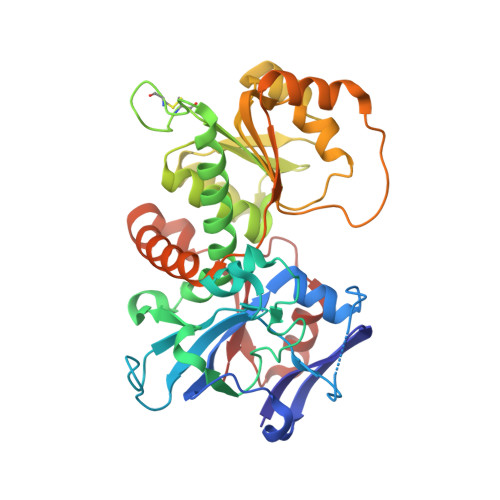The Structural Basis of Substrate Promiscuity in Glucose Dehydrogenase from the Hyperthermophilic Archaeon Sulfolobus Solfataricus.
Milburn, C.C., Lamble, H.J., Theodossis, A., Bull, S.D., Hough, D.W., Danson, M.J., Taylor, G.L.(2006) J Biol Chem 281: 14796
- PubMed: 16556607
- DOI: https://doi.org/10.1074/jbc.M601334200
- Primary Citation of Related Structures:
2CD9, 2CDA, 2CDB - PubMed Abstract:
The hyperthermophilic archaeon Sulfolobus solfataricus grows optimally above 80 degrees C and utilizes an unusual, promiscuous, non-phosphorylative Entner-Doudoroff pathway to metabolize both glucose and galactose. The first enzyme in this pathway, glucose dehydrogenase, catalyzes the oxidation of glucose to gluconate, but has been shown to have activity with a broad range of sugar substrates, including glucose, galactose, xylose, and L-arabinose, with a requirement for the glucose stereo configuration at the C2 and C3 positions. Here we report the crystal structure of the apo form of glucose dehydrogenase to a resolution of 1.8 A and a complex with its required cofactor, NADP+, to a resolution of 2.3 A. A T41A mutation was engineered to enable the trapping of substrate in the crystal. Complexes of the enzyme with D-glucose and D-xylose are presented to resolutions of 1.6 and 1.5 A, respectively, that provide evidence of selectivity for the beta-anomeric, pyranose form of the substrate, and indicate that this is the productive substrate form. The nature of the promiscuity of glucose dehydrogenase is also elucidated, and a physiological role for this enzyme in xylose metabolism is suggested. Finally, the structure suggests that the mechanism of sugar oxidation by this enzyme may be similar to that described for human sorbitol dehydrogenase.
Organizational Affiliation:
Centre for Biomolecular Sciences, University of St. Andrews, North Haugh, St. Andrews, Fife KY16 9ST, Scotland, UK.















